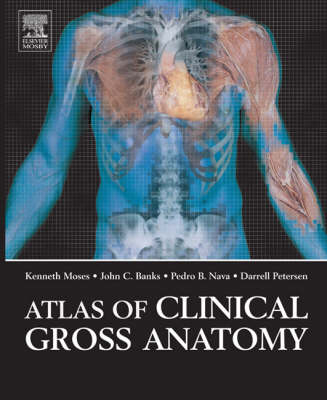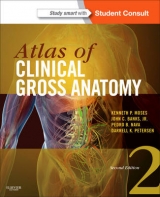
Atlas of Clinical Gross Anatomy
Mosby (Verlag)
978-0-323-03744-0 (ISBN)
- Titel erscheint in neuer Auflage
- Artikel merken
Winner of the Richard Asher Prize for a First Medical Textbook for Students
Responding to current trends in anatomy curricula, this innovative new resource covers surface and radiologi¬cal anatomy and cutaneous and muscular innervations as well as gross anatomy. Outstandingly realistic three-dimensional photographs and illustrations, plus a consistent chapter organization, summary tables, and other user-friendly features, enhance readers' mastery of essential information. It provides students with a unique resource for use before, during and after lab work, in preparation for examinations, and later on as a primer for clinical work.
LARGE PHOTOS, typically just one per page, taken in such a way as to be as intuitive as possible: so, no more squinting over a small photo or wondering where on the live body the dissection image might relate to;
DIGITAL PHOTOSHOP TECHNIQUES used on some of the dissections to color enhance structures and thereby combine the best features of a photo atlas and an artwork atlas; so, no more puzzling over structures that are hard to distinguish from the background of the dissection, a criticism often levelled at photographic atlases;
Simple, non-parallel LEADER LINE LABELLING as opposed to matching numbers to a key at the bottom of the page: so, no need to spend time trying to find a number on a dissection, then matching it to a key at the bottom of the page;
SPECIALLY COMMISSIONED DISSECTIONS, all done to a uniformly high standard, all using cadavers that have been freshly dissected and prepared using low alcohol fixative: so, each dissection will look "fresh", not "washed out", while remaining intuitively easy to understand and reproduce in the dissection lab;
Navigational BODY REGION ICON on the top right hand corner of every double page spread: so, no more flicking back and forth trying to find a particular part of the body - no need even to consult the Contents pages or Index for navigation purposes;
RIGOROUSLY CONSISTENT, "SUPERFICIAL TO DEEP" chapter structure: * Introductory overview text * Clinical correlations text * Surface anatomy illustration * Superficial dissection(s) * Muscle review table * Intermediate dissection(s) * Deep dissection(s) * Osteology & X-Ray * Each chapter follows the same pattern throughout so the reader will always know exactly what coverage to expect, and in which order;
Concise REVIEW TEXT including BOLD FACE TERMS and MNEMONICS: so, the student will be able to obtain a quick overview of the structures to be illustrated on the following pages and clarify any questions s/he may have about anatomic relationships;
Short CLINICAL CORRELATIONS text that bridges the gap between gross anatomy and clinical practice thereby enlivening the descriptive anatomy and relating it to real-life practice;
Photographic material which reflects not just the lab setting but also the PHYSICAL EXAM and SURGICAL INTERVENTIONS that students will encounter later on in clinical practice;
SURFACE ANATOMY for every structure with MUSCLES, major BONES and CUTANEOUS INNERVATION "ghosted" on to the surface: so, the student can learn to relate surface landmarks to underlying structures of clinical relevance;
SUMMARY TABLES for origin, insertion, innervation, action and blood supply of muscles: this is ideal for self-testing and review purposes, students have raved about this feature;
CROSS SECTIONS, X-RAYS, MRIs, CTs, ANGIOGRAMS, ENDOSCOPIC and LAPARASCOPIC VIEWS at the end of each chapter, to help the student (a) learn to identify structures as they will later appear during clinical practice and then, (b) when s/he starts to see these diagnostic techniques during clinical rotation, recognise where on the body the image relates to.
1.Introduction to Anatomy
UNIT 1: HEAD & NECK
2.Introduction to Head and Neck
3.Skull
4.Scalp and Face
5.Parotid, Temporal and Pterygopalatine Regions
6.Eye
7.Ear
8.Nose
9.Oral Region
10.Pharynx and Larynx
11.Submental Region
12.Anterior Triangle
13.Posterior Triangle/Deep Neck
UNIT 2: UPPER LIMB
14.Introduction to the Upper Limb
15.Breast and Pectoral Regions
16.Axilla/Brachial Plexus
17.Scapular Region
18.Shoulder Complex
19.Arm
20.Elbow Joint/Cubital Fossa
21.Anterior Forearm
22.Posterior Forearm
23.Wrist and Hand Joints
24.Hand Muscles
UNIT 3: TRUNK
25.Introduction to Trunk
26.Vertebral Column
27.Suboccipital Region
28.Back Muscles
29.Chest Wall and Mediastinum
30.Heart
31.Lungs
32.Diaphragm/Posterior Abdominal Wall
33.Abdominal Organs
34.Gastrointestinal Tract
35.Anterolateral Abdominal Wall/Inguinal Region
36.Pelvic Girdle
37.Pelvic Viscera - Male and Female
38.Perineum
UNIT 4: THE LOWER LIMB
39.Introduction to the Lower Limb
40.Anteromedial Thigh
41.Hip Joint
42.Gluteal Region/Posterior Thigh
43.Knee Joint and Popliteal Fossa
44.Anterolateral Leg
45.Posterior Leg
46.Ankle and Foot Joints
47. Foot
| Erscheint lt. Verlag | 6.6.2005 |
|---|---|
| Verlagsort | St Louis |
| Sprache | englisch |
| Maße | 246 x 189 mm |
| Themenwelt | Medizin / Pharmazie ► Medizinische Fachgebiete |
| Studium ► 1. Studienabschnitt (Vorklinik) ► Anatomie / Neuroanatomie | |
| ISBN-10 | 0-323-03744-5 / 0323037445 |
| ISBN-13 | 978-0-323-03744-0 / 9780323037440 |
| Zustand | Neuware |
| Haben Sie eine Frage zum Produkt? |
aus dem Bereich



